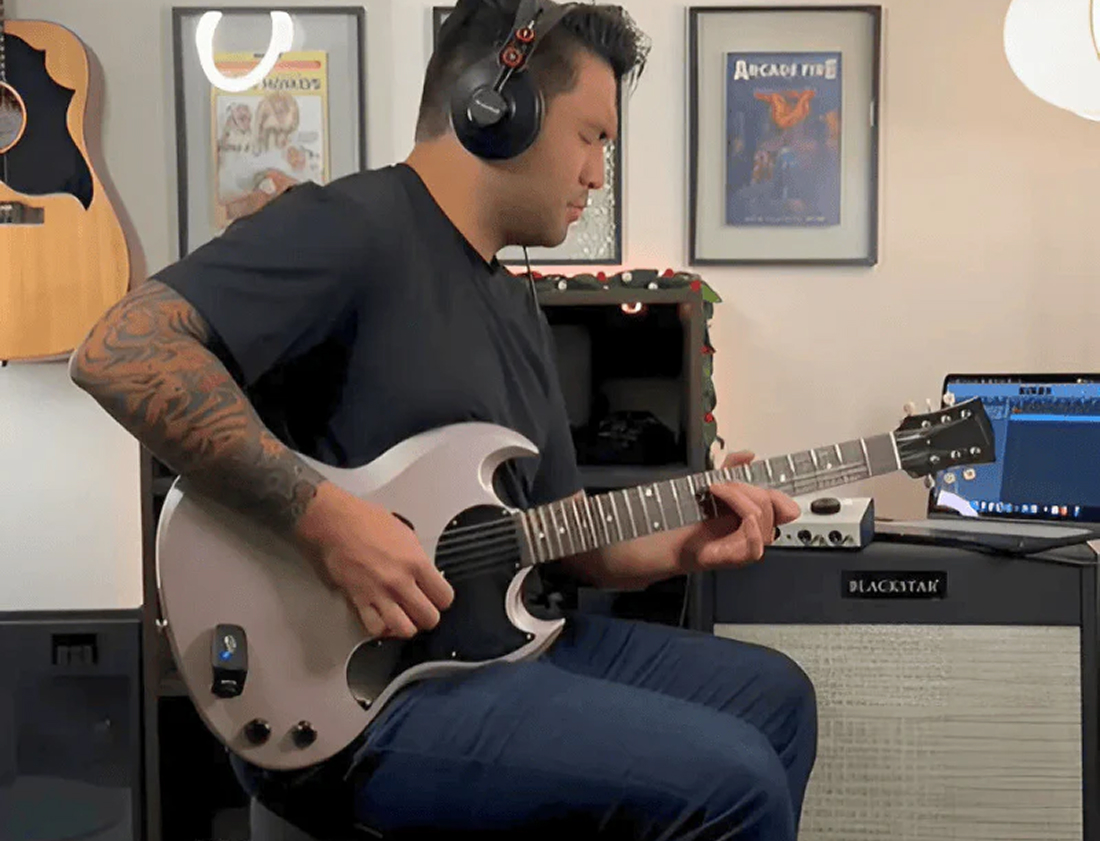

Picture this: You're mid-solo during the biggest gig of your career when suddenly—your guitar cable fails. The crowd's cheers turn to confused murmurs as you scramble to fix the connection. 😱 This nightmare scenario happened to me three times before I discovered the transformative power of professional wireless guitar systems.
Traditional cables don't just limit your movement—they're ticking time bombs for technical disasters. I've seen musicians trip over cords, suffer signal degradation from cheap wiring, and even damage expensive input jacks from repeated plugging/unplugging. 🎸 The worst part? These issues always seem to strike at the worst possible moment.
After testing dozens of systems, I can confidently say that modern wireless technology has eliminated these problems. The best systems now deliver cable-like tone quality with ultra-low latency under 4ms—faster than human perception. No more being tethered to your amp or worrying about cable failures during crucial performances.
What surprised me most was discovering how wireless systems can actually improve your sound. High-end models provide wider frequency response than many cables, with 24-bit/48kHz digital transmission that preserves every nuance of your playing. 🎶
In this guide, I'll share the best 5 wireless guitar systems that passed my rigorous testing—from budget-friendly options to pro-grade setups. Whether you're a bedroom player or touring musician, cutting the cord might be the best musical decision you'll make this year. Let's explore what makes these systems stand out!
Measures how accurately the system reproduces your guitar's natural tone, including frequency response range and signal-to-noise ratio.
Evaluates signal delay times, with professional systems delivering under 5ms for imperceptible wireless transmission.
Tests maximum reliable distance between transmitter and receiver without signal dropout, crucial for stage performances.
Assesses continuous playtime per charge and charging convenience, with top systems offering 8+ hours of runtime.
The LiveStrung Wireless Guitar System redefines wireless freedom for musicians with its studio-grade audio clarity and ultra-low latency. Designed for both electric and acoustic instruments, it eliminates the hassle of cables while preserving your tone's integrity. 🎸 Its 5.8GHz frequency avoids interference from common devices, making it ideal for crowded stages or home studios.
With a 48kHz/24-bit sampling rate, this system captures every nuance of your performance, from delicate fingerpicking to aggressive strumming. The sub-4ms latency ensures real-time response, so you'll never feel disconnected from your amp. 🔥 Six channel banks let you dodge frequency clashes during live shows, while the 270° swivel head fits most guitar jacks securely.
Musicians will appreciate the 8-hour battery life and 100ft range, perfect for dynamic performances. The included Y-split charging cable keeps both transmitter and receiver powered simultaneously. 🎶 Compatible with keyboards, e-drums, and basses, it's a versatile solution for multi-instrumentalists.
The enhanced dynamic range (113dB) and minimal distortion (<0.02%) ensure your tone stays pristine. Whether you're a bedroom player or touring pro, the LiveStrung delivers uncompromised wireless performance without sacrificing sound quality. 🏱️ Setup takes seconds—just plug and play.
Compared to 2.4GHz systems, the 5.8GHz band offers superior interference resistance. The compact design (just 36g) won't weigh down your strap, and the USB charging adds convenience. 🌟 For musicians seeking cable-free reliability, this system is a game-changer.
PROS
CONS
The NUX Wireless Guitar System is a versatile and reliable choice for musicians seeking wireless freedom without compromising tone quality. Its 2.5ms ultra-low latency ensures seamless performance, making it ideal for both studio and live settings. The system also features a built-in booster and digital tuner, adding convenience for on-the-go adjustments.
One standout feature is the cable tone simulation, which provides a warmer sound for guitarists who prefer the traditional wired feel. The system's stable mode effectively minimizes interference, ensuring consistent audio transmission. With a range of up to 50 meters, it’s perfect for larger stages or outdoor performances.
The long battery life of 6.5 hours ensures uninterrupted playtime, and the rechargeable Li-ion battery is a practical touch. The automatic pairing system simplifies setup, allowing musicians to focus on their performance. This system is compatible with a wide range of instruments, including electric guitars, bass guitars, and more.
While the NUX system excels in many areas, its stable mode requires careful positioning to avoid interference from Wi-Fi devices. The included send/return routing options make it easy to integrate with effect pedals, enhancing its versatility. Overall, this system offers exceptional value for its price point.
For musicians looking for a reliable and feature-packed wireless solution, the NUX Wireless Guitar System is a top contender. Its combination of low latency, long range, and practical features makes it a standout choice in its category.
PROS
CONS
The Audix Wireless Guitar System is designed for musicians who want a hassle-free transition from cables to wireless. Its 300-foot operating range makes it suitable for small to midsize venues, ensuring reliable performance. The system includes a clip-on bodypack for easy attachment to clothing or straps.
One of the key features is the 1-touch channel selection, which simplifies setup and ensures quick pairing. The advanced circuitry delivers faithful reproduction of guitar and bass tones, maintaining audio quality. The included custom instrument cable adds versatility to the setup.
The long-lasting AA battery life ensures extended playtime without frequent replacements. The system’s rugged rackmountable design adds durability, making it a reliable choice for touring musicians. Its B-band frequency range (554–586MHz) provides clear and detailed sound.
While the Audix system excels in simplicity and range, its AA battery dependency may be a drawback for some users. The clip-on bodypack is convenient but may not suit all playing styles. Overall, this system is a solid choice for musicians seeking reliable wireless performance.
For those who prioritize ease of use and clear sound, the Audix Wireless Guitar System is a worthy option. Its combination of range, simplicity, and durability makes it a dependable choice for live performances.
PROS
CONS
The Shure Wireless Guitar System stands out with its Dual Band Wireless Technology, operating in both 2.4 and 5.8GHz bands for reliable performance. This system intelligently avoids interference, ensuring dropout-free audio. Its smart rechargeability feature offers up to 12 hours of runtime, with quick charge capabilities.
One of the highlights is the automatic pairing and frequency management, which simplifies setup and ensures optimal performance. The system’s transparent audio quality makes it a favorite among professional musicians. It’s available in various configurations, including rack-mount and guitar pedal options.
The quick charge feature provides 1.5 hours of use from just 15 minutes of charging, ideal for last-minute performances. The system’s license-free frequency range allows for hassle-free travel. However, its higher price point may be a barrier for some users.
While the Shure system excels in audio quality and reliability, its compatibility is limited to GLX-D+ models. The included tuner and 1/4" guitar input add convenience for musicians. Overall, this system is a premium choice for those who demand the best.
For professionals seeking top-tier performance and versatility, the Shure Wireless Guitar System delivers. Its advanced features and reliable performance make it a standout in the wireless guitar system market.
PROS
CONS
The Positive Grid Wireless Guitar System is a versatile option for musicians who want multi-channel functionality. It supports guitar, bass, vocals, and more, with built-in mixing and effects. The system’s Sonic IQ computational audio ensures balanced, full-spectrum sound across all channels.
One of the standout features is the smart app integration, which allows for extensive tone customization. The system includes 33 amps and 43 effects, offering endless creative possibilities. Its portable design and optional rechargeable battery make it ideal for gigs anywhere.
The 8-hour battery life ensures extended playtime, and the swappable batteries add convenience. However, the system’s higher price point may be a drawback for budget-conscious musicians. The Bluetooth streaming feature allows for easy backing track playback.
While the Positive Grid system excels in versatility and features, its complexity may overwhelm beginners. The included USB-C charging cable and power cord add to its practicality. Overall, this system is best suited for tech-savvy musicians.
For those who want advanced features and flexibility, the Positive Grid Wireless Guitar System is a compelling choice. Its combination of multi-channel support and smart app integration makes it unique in the market.
PROS
CONS
A wireless guitar system eliminates cables between your guitar and amplifier, providing freedom of movement on stage or in the studio. These systems transmit your guitar's signal via radio frequencies, maintaining audio quality while removing tripping hazards and setup limitations.
The technology has advanced significantly, with modern systems offering near-zero latency and high-fidelity sound reproduction comparable to wired connections. Professional musicians and hobbyists alike benefit from the convenience and reliability of these systems.
Key components include a transmitter that attaches to your guitar and a receiver that connects to your amplifier or audio interface. Some systems feature digital transmission for improved signal integrity and reduced interference.
When choosing a wireless system, consider your performance needs, as different models offer varying operating ranges and battery life. High-end systems provide additional features like multiple channels and frequency scanning to avoid signal dropouts.


© 2024 LumiReview. All Rights Reserved.
Our hands-on testing and expertise produce reviews that balance subjectivity with reliability. We evaluate products on multiple criteria, including quality, user-friendliness, and value. This content is an advertisement featuring well-researched information from actual users, not a news article or personal blog.